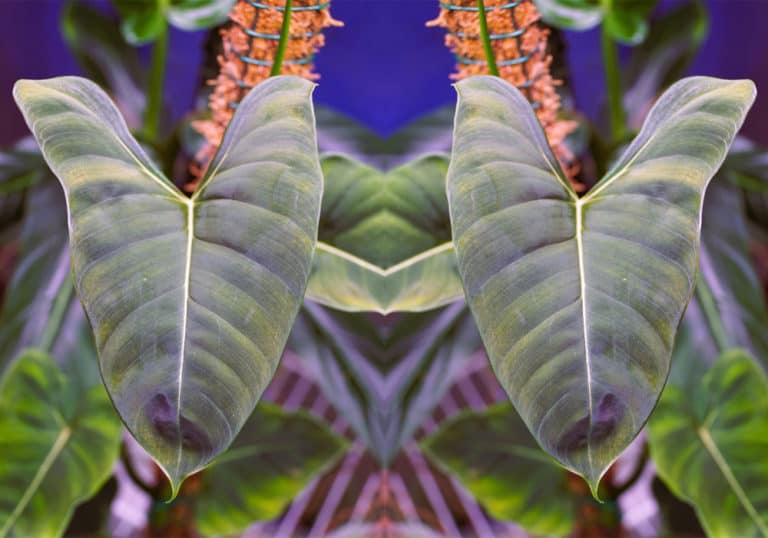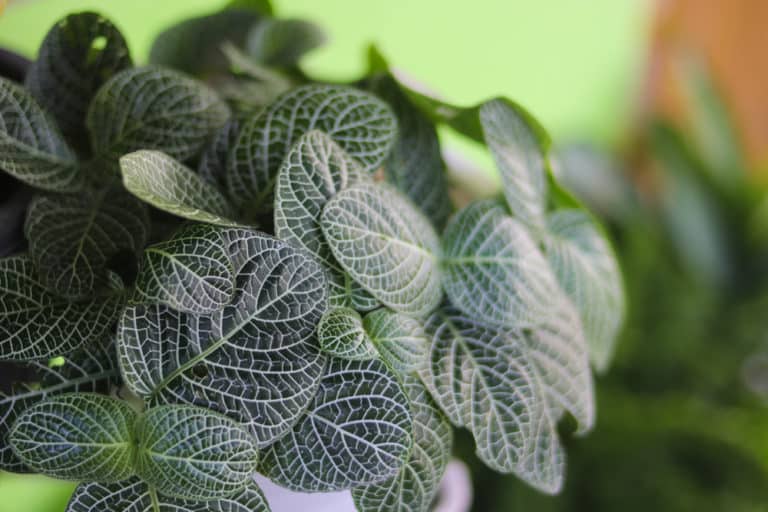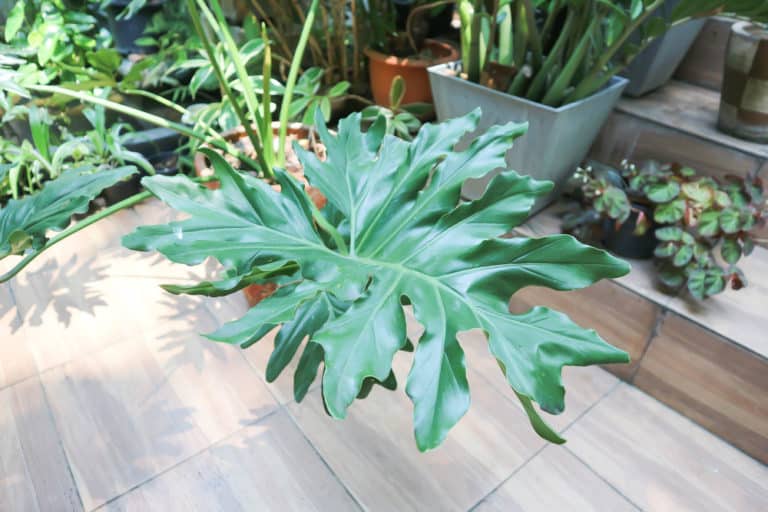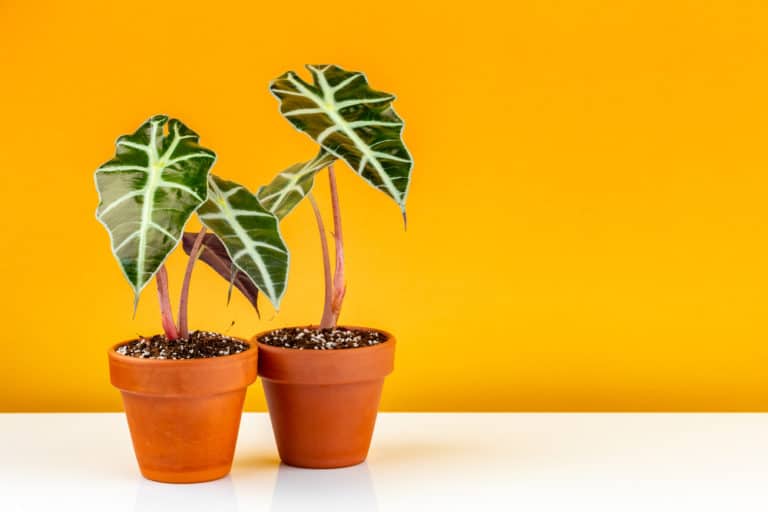Gynura Aurantiaca ‘Purple Passion’ Care Guide (2024)
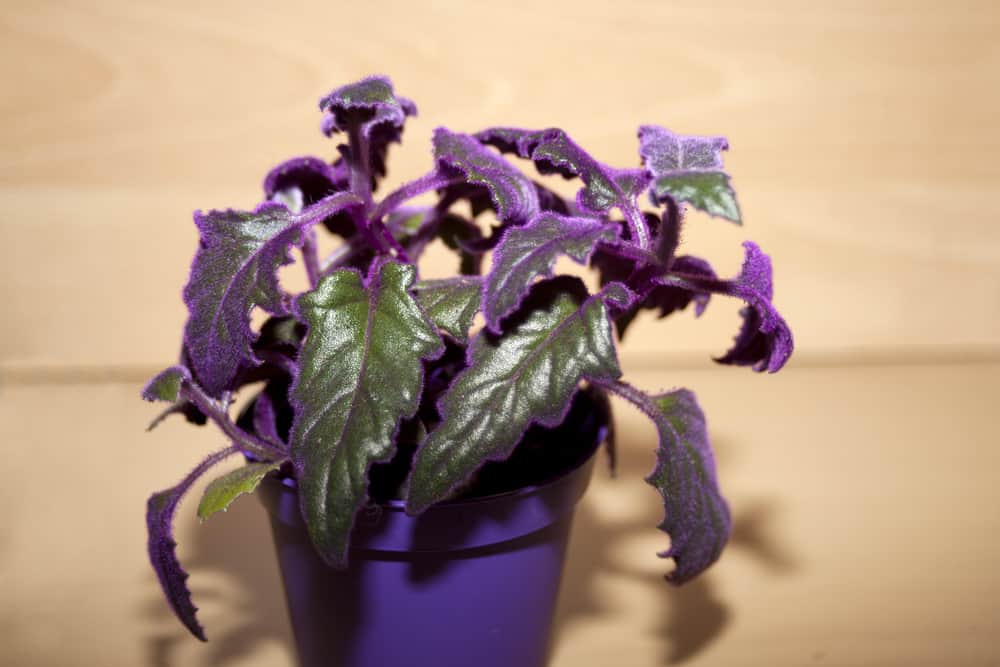
The Purple passion plant or Gynura aurantiaca is a small-growing majestic plant that is highly distinguished for its deep green foliage that are covered in tiny purple hairs.
These hair-like structures are responsible for the plant’s interesting leaf coloration.
Yet other than its aesthetic features, the plant is also easy to care for. So, you’ll never regret taking home the Velvet plant to add to your collection!
| Scientific Name | Gynura aurantiaca |
| Common Name | Purple Passion Houseplant, Purple Velvet, Velvet Plant |
| Light | Bright indirect sunlight; Partially shaded |
| Watering | Weekly, water if the top half of the soil is dry |
| Temperature | 60°F (15°C) |
| Hardiness Zone | USDA hardiness zones 9a (20°F) to 10b (35°F) |
| Humidity | 40-60 % |
| Soil Type | Rich in OM, quick-draining |
| Soil pH | Slightly acidic (6.1–6.5 pH) |
| Fertilizing | A balanced feed once a month in spring and summer |
| Repotting | When the plant has become rootbound |
| Pruning | Beginning of the growing season |
| Propagation | Stem cuttings |
| Toxicity | Generally non-toxic |
| Mature Size | Can grow up to 6 feet tall |
| Bloom Time | Winter |
What’s Unique About Gynura aurantiaca?
The Gynura aurantiaca plant is a fuzzy specimen notable for its deep green leaves that are covered with tiny purple hair-like structures. Because of this, a hint of purple color is found in almost every part which tends to become more intense whenever light touches the plant.
Each leaves of the Gynura aurantiaca have a pronounced serration along the leaf blade, giving it an unusual but fairly interesting looks. Gynura aurantiaca plants are reportedly native to the tropical regions of Southeast Asia.
As a member of the plant family Asteraceae (similar to Daisies), Gynura aurantiaca plants are slowly making its way to being the most highly coveted houseplants in the region.
Gynura aurantiaca Care
Greatly adored for its fuzzy purple foliage, the purple passion plant are an ideal houseplant which grows favorably under bright indirect light. The Gynura aurantiaca plant care also involves the use of a moist but well-draining soil, a regular watering cycle, and a high level of humidity. Read further below so you can be best equipped when it comes to purple passion plant care!
Light
The leaf coloration of the Purple velvet plant is greatly influenced by light intensity. To maintain its delightful color, Gynura aurantiaca light requirements is a bright indirect light. So when grown indoor, the plant may be placed near an east-facing window to receive the first soft rays of the sun.
The Purple passion plant light needs are not as complicated as the other exotic looking houseplants. Full sun exposure proves to be beneficial in maintaining its vibrance, while the lack of sunlight can consequently dull the leaves of your plant.
Note: It is still important not to expose the plant to harsh and scorching light for longer periods of time, as this can cause irreversible damage to the delicate foliage. Hence, it is recommended to plant them underneath a taller plant for protection.
Watering
Gynura aurantiaca watering should be balanced. They hate sitting in water, especially for longer periods of time, as this predisposes them to root rot.
As a general rule of thumb, water purple passion plant at least once a week. Excess water should easily drain out from a container with sufficient drainage holes, so be sure to use one. It’s also important that the leaves are not in contact with water as this can also cause decay.
You may easily check the watering needs of your Purple passion plant by simply touching the soil (about an inch) first to see if it is already dry.
Temperature
As a plant of tropical descent, the Gynura aurantiaca temperature range usually sits above 60°F (15°C). It will thrive in an average room setting so you need not worry how you can maintain the ideal temperature for purple passion plant indoors.
Note that the plant does not possess a low temperature tolerance so you should try to avoid anything below 59°F (15 °C).
The Purple passion plant is reportedly hardy to USDA hardiness zones 9a (20°F) to 10b (35°F). If the plant is grown outside, you have to bring it in during winter as it tends to be vulnerable to freezing injury.
Humidity
Considering the kind of the environment from which the plant originates, the Gynura aurantiaca humidity requirements are from moderate to high. Nevertheless, the plant is known to grow well even with a little bit of neglect, hence, it will still thrive in areas with lower humidity level.
Maintaining the ideal humidity for purple passion plant may require occasional misting or investing in a humidifier. But the most practical method of increasing air moisture is by setting up a pebble tray in which the plant is often placed above.
A humidity that is too high can also harm your plant and makes it vulnerable to pests and diseases. So you should always aim for at least 40% to 60%.
Soil
The ideal Gynura aurantiaca soil consists of a rich, moist, but well-draining substrate. Avoid using a clumpy soil mix as this makes the plant susceptible to waterlogging. You can create your own soil for purple passion plant by mixing garden soil, two parts peat moss, and one part sand.
The ph level for purple passion plant is ideally low, hence slightly acidic (6.1–6.5 pH). Adding some organic matter in the soil lowers down pH, thus, your peat moss serves dual purpose: for increasing moisture retention and for gradually increasing soil acidity.
If you wish to be in the safe zone, you can always use a regular potting soil that drains well and stays slightly moist but not too heavy.
Fertilizer
You can give Gynura aurantiaca fertilizer during the growing season, for this is the period of most active growth. You may apply a diluted liquid fertilizer (with half the recommended strength) once a month in order to encourage more vibrant and luscious foliage formation.
Pro tip: Use a balanced fertilizer ratio such as 10-10-10 or 20-20-20. You can also use a commercially bought fertilizer for purple passion plant but be sure to avoid cheaper ones as these tend to accumulate in the soil, causing a potential build up of heavy metals. Since the plant is a vigorous grower, it will enjoy regular feeding during spring and summer.
Potting & Repotting
Gynura aurantiaca repotting is typically done during springtime. Since they tend to grow faster, they can easily become rootbound and outgrow their current pot. However, it is often a good idea to just prune the plant and use the cuttings as propagules.
When repotting purple passion plants, always choose a pot size that is twice of the original container and with drainage holes. Fill the new container with half of the fresh potting mix and gently place the plant in the center. Fill in the remaining soil and water the plant thoroughly. Be sure to place your plant in an area that receives an ample amount of light.
Pruning
When it comes to Gynura aurantiaca pruning, the most obvious signs are the plant’s leggy and stretchy appearance. When these plants mature, you can expect that the leaves will become dull and the shoots are sometimes deformed. This is because the assimilates needed for new growth are being utilized by the already spent and decaying portions of the plant.
To prevent this, make it a habit to trim old leaves and stems. This will not only promote new growth, but can also prevent the occurence of pests and diseases.
When cutting purple passion plant, be sure to use sterile shears or pruning knives. Do not overdo it i.e. not more than 5 inches above the soil line.
Propagation
The Gynura aurantiaca propagation is an important aspect of plant care, as this plant only lasts for a few years. Hence, taking cuttings from the mother plant, and allowing them to root is your best option for re-growing this specimen.
To propagate purple passion plant, simply remove a few stem tops, preferably of those that are already beginning to form flowers. Afterwards, plant the propagules in a moist, loamy potting mix. Cover the pot with a plastic bag with a few holes for 2-3 weeks to ensure a higher rate of root information. Place it on a spot that receives ample amounts of light and water as needed.
Common Problems of Gynura aurantiaca
Despite the plant’s ease of care, some Gynura aurantiaca problems may still arise due to the presence of pests and diseases – affecting either stem, roots, and leaves. But with proper cultural management, you may prevent some of these from ever occurring. Below are guides on how you can mitigate some of the problems with purple passion plant:
Pests
Some of the most common Gynura aurantiaca pests are aphids, mealy bugs, spider mites, and leaf scales. They feed off the leaves of your plant, taking nutrients that can otherwise be utilized to support growth and development.
Pro tip: When dealing with pests, you can spray your purple passion plant with rubbing alcohol or use horticultural oils such as neem oil and citronella oil. These two are proven effective to repel feeding insects that can proliferate on your plant. Also, make it a habit to wipe off the leaves and stems in order to remove residues (e.g. sooty molds) and dust.
Diseases
Waterlogging is a notorious killer of many houseplants, and it is said that the plant can easily survive for some time without adequate watering, but rarely survives after prolonged periods of waterlogging.
Waterlogging can lead to a depletion of oxygen in the root system of your purple passion plant – later causing symptoms such as yellowing of the leaves, decaying of plant tissues, and softening of the root system. Hence, the importance of following the right watering cycle.
Pruning is also a good practice to get rid of infected plant parts should there be an occurrence of some Gynura aurantiaca diseases.
Growing Problems
While growing Gynura aurantiaca is considered relatively easy, there may still come a time when you will have to deal with infestation and infection. However, observing proper cultural management goes a long way when it comes to disease prevention.
When tending to a sick plant, investigate first for the cause and treat accordingly. You may also prune the infected plant parts in order to revive and save the parts that can still be used for propagations.
Note that growing problems may arise from several factors such as light, water, fertilizer, temperature, and humidity. Hence, it’s always best to check and attain the ideal growing conditions for your plant to thrive.
Toxicity of Gynura aurantiaca
If you are one of those plant enthusiasts that also have a lot of furry friends at home, you will be relieved that the purple passion plant has no known level of toxicity and is therefore not considered toxic to both animals and small children. They are completely safe to keep around the house and there are no health concerns regarding this tropical beauty.
For Humans
Thankfully the Gynura aurantiaca are not considered toxic to both small children and adults. Humans need not worry about having the plant in their homes because it does not possess any toxic characteristics. Hence, the purple passion plant challenges the common belief that any exotic looking plant has some degree of toxicity. Currently, there have been no negative health concerns that may be attributed to the purple passion plant.
Note, however, that it is still not advisable to consume any parts of the plant as it may still have certain metabolites which the body may have an adverse reaction to.
For Pets
It’s important to keep in mind that an animal’s level of toxicity still varies, hence it is best to avoid placing your purple passion plants in an area where your pets can easily access them. Nibbling of any plant parts should still be prevented even if not considered toxic so as to avoid any health problems.
As mentioned earlier, plants are capable of releasing certain secondary metabolites in response to their growing environment. These organic substances, if taken in large amounts, can potentially cause harm to your furry friends particularly in their digestive system. Hence, you should discuss safety precautions with your veterinarian.
Gynura aurantiaca Appearance
The majestic Gynura aurantiaca appearance is attributed to its interesting set of foliage adorned by purplish hair-like structures. This woody-based evergreen perennial is a perfect addition to your plant collection – livening up spaces and bringing in that exotic vibe. Below are more in depth information regarding the best features of this stunning plant.
Foliage
The foliage of Gynura aurantiaca needs no introduction. It is considered the most important feature of the plant due to its intricate detail and purplish glow. This purple colored hair-like structure are highlighted whenever light hits the foliage. Adding in to the somewhat enchanting look of the plant.
Each leaf can grow up to 8 inches long and ovate in appearance. The unusual look of the plant is all the more highlighted by the pronounced serration found along its blade.Yet other than its looks, the plant is also recognized for its ability to grow upright and eventually adapt to a vine-like growing pattern.
Flowering
Gynura aurantiaca flowering can occur as soon as the plant reaches maturity. The blooming period usually occurs in winter by which the plant will soon be graced with tiny clusters of senecio-like orange yellow flowers, particularly known as corymbs.
The purple passion plant flower rarely does form when grown in lower light conditions. And when it does, many growers prefer to remove them as it tends to emit an unpleasant smell or odor. Hence, the Purple passion is more often grown as a foliage plant.
Pro tip: If you wish to encourage more foliage development, you can trim off spent leaves, stems, and flowers from the plant from time to time.
Size and Growth
In their native habitat, the size of Gynura aurantiaca can go up to two (2) feet tall and four (4) feet wide. Meanwhile, the leaves can grow up to eight (8) inches long.
The purple passion plant has a relatively fast growth rate, and when they are grown outside as an annual, it is recommended to place the plant in a container in order to prevent them from uncontrollably spreading.
Because of their sprawling and a vine-like habit, they can reach a height of over 4 to 6 feet tall. Hence, a pleasing wall accent and an ornamental specimen whether indoor or in a garden.
Gynura aurantiaca Fragrance
The Gynura aurantiaca fragrance is considered obnoxious. The odor is emitted by the flowers which tend to bloom during winter. The unpleasant scent is perhaps an adaptive response of the plant in order to attract pollinators. This is also the reason why the flowers are often removed in domestication.
Note: When the plant is infected with a disease, a smell may be emitted to signal the presence of a pathogen. For example, root rotting can cause unpleasant odors to be released from the base of the plant. Similarly, an odor may also come from decaying parts such as leaves and stems.
Suggested Uses for Gynura aurantiaca
The adorable Gynura aurantiaca is your perfect accompaniment plant that can either be grown indoors and outdoors. Yet aside from livening up rather dull spaces, the plant also possesses some air purifying ability, filtrating certain pollutants found in most homes.
When grown outside, you can have them planted along borders or underneath your taller ornamental plants. You can also let them climb on a trellis depending on your desired height.
If grown inside your home, you’ll certainly enjoy the presence of your purple passion plant placed on your countertop, cabinets, bedroom tables, and windowsills – provided that the area has adequate light and is fairly humid.
FAQ
What is Gynura aurantiaca?
The Gynura aurantiaca is a small growing majestic plant that is highly distinguished for its deep green ovate foliage that are covered in tiny purple hairs.
How to identify Gynura aurantiaca?
The Gynura aurantiaca can be easily distinguished among other houseplants through its leaves that are adorned with purple colored hair-like structures that are highlighted whenever light hits the plant.
How to care for Gynura aurantiaca?
The Gynura aurantiaca plant care involves exposure to bright indirect light, use of a moist but well-draining soil, a regular watering cycle, and a high level of humidity.
How to grow Gynura aurantiaca indoors?
When growing the Gynura aurantiaca indoors, be sure to provide the plant with sufficient light as well as the appropriate temperature and humidity of at least 60°F, and 40-60%, respectively.
How to grow Gynura aurantiaca outdoors?
It may be best to grow your Gynura aurantiaca underneath your other ornamental plants in order to protect the plant from the harsh rays of sun.
How fast does Gynura aurantiaca grow?
The Gynura aurantiaca are considered fast growers, hence if not contained, can easily spread to any ground. The plant can grow at about 5-6 feet tall.
How tall does Gynura aurantiaca grow?
In their wild habitat, Gynura aurantiaca plants can grow from 4 to 6 feet tall. With a climbing support, purple passion plants can sprawl to just about any length. When young, they maintain an upright position.
How to make Gynura aurantiaca grow faster?
You can apply balanced fertilizer on your Gynura aurantiaca at half strength during the growing season, particularly during spring and summer – where the period of active growth takes place.
How to stake Gynura aurantiaca?
To support their growth, you can place a small stake behind your Gynura aurantiaca to train them as they begin to develop more leaves and stems.
How to pot Gynura aurantiaca?
Fill the new container with half of the fresh potting mix and gently place the plant in the center. Fill in the remaining soil and water the plant thoroughly.
How to revive Gynura aurantiaca?
If you noticed that your Gynura aurantiaca appears to be lifeless, you may try to prune off the decaying and spent leaves, stems, and even flowers. This will encourage new shoots to form.
Why is my Gynura aurantiaca dying?
Waterlogging is the most common problem that may cause injury to your plant. Due to limited oxygen, the flow of nutrients become limited and tissues may begin to rot, causing yellowing and stunted growth.
Why is my Gynura aurantiaca drooping?
Drooping of the leaves may be caused by several factors such as overwatering, underwatering, presence of insect pests, and an impending disease. Check the plant regularly and treat accordingly.
How cold can Gynura aurantiaca tolerate?
Due to low temperature tolerance, you should try to avoid temperature below 59°F (15 °C) as this predisposes your purple passion plant to freezing injury.
How to get rid of pests on Gynura aurantiaca?
Some of the natural ways to get rid of pests on your houseplants are pruning, regular wiping off of leaves, and use of horticultural oil such as neem oil and citronella.
Is Gynura aurantiaca toxic to cats?
While the plant is generally considered non-toxic, its toxicity to animals still vary. Hence, it is safer to avoid them having access to your purple passion plant.
Is Gynura aurantiaca toxic to dogs?
The level of toxicity of the purple passion varies in animals, hence dogs should still be protected and restricted from having direct access to the plant.
Is Gynura aurantiaca toxic to children?
Gynura aurantiaca plants are considered non-toxic to humans, particularly in small children. However, parts of the plant should still not be ingested or consumed in any way.
Is Gynura aurantiaca toxic to humans?
Gynura aurantiaca plants are generally not considered toxic to humans. However, there may be some reactions that may affect a person such as allergy and mild toxicity, hence they should not be consumed.
Does Gynura aurantiaca have a scent?
The Gynura aurantiaca is known to develop flowers that have some unpleasant fragrance, often regarded as foul, but could serve other purposes in nature such as for attracting pollinators.


